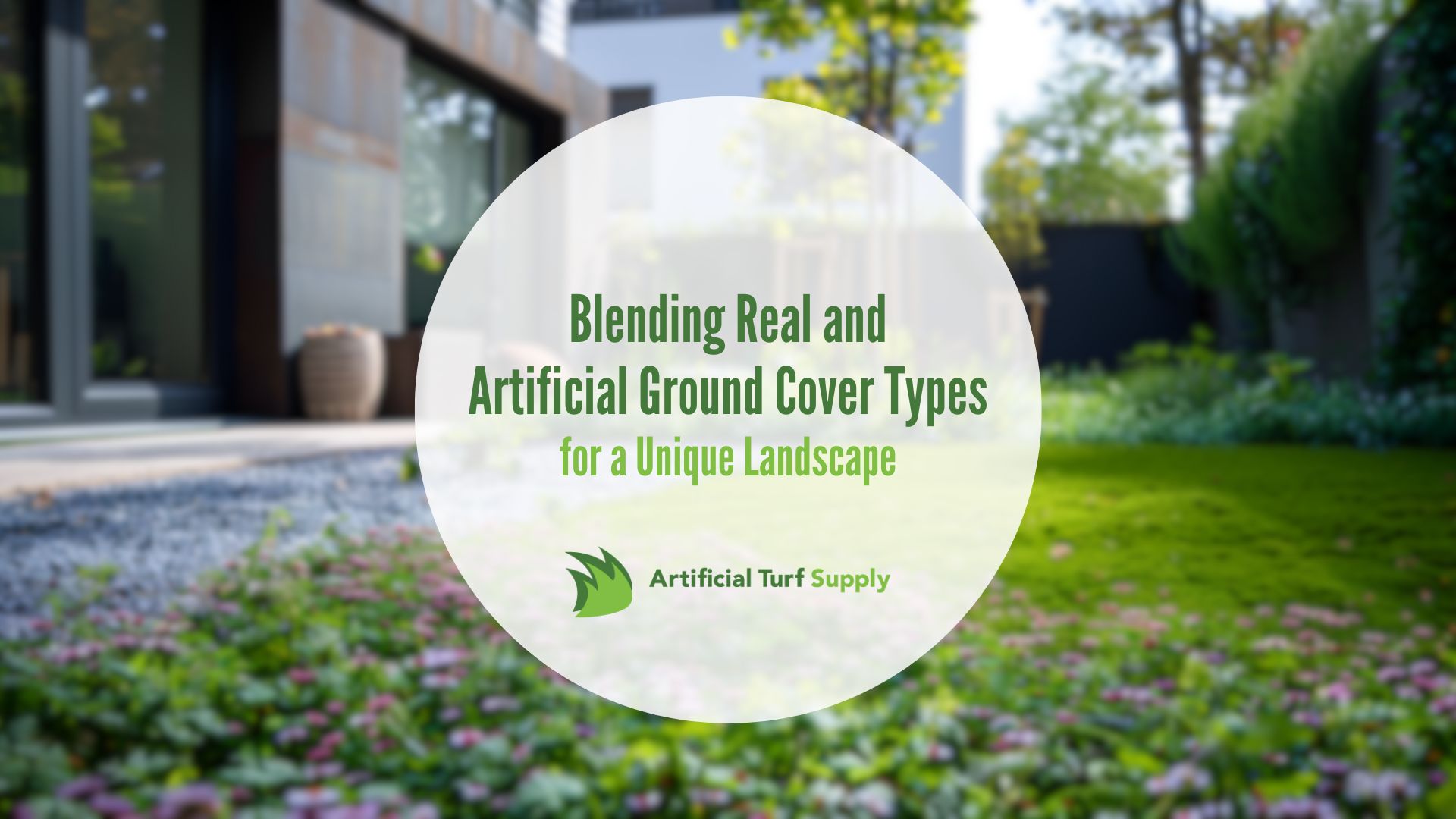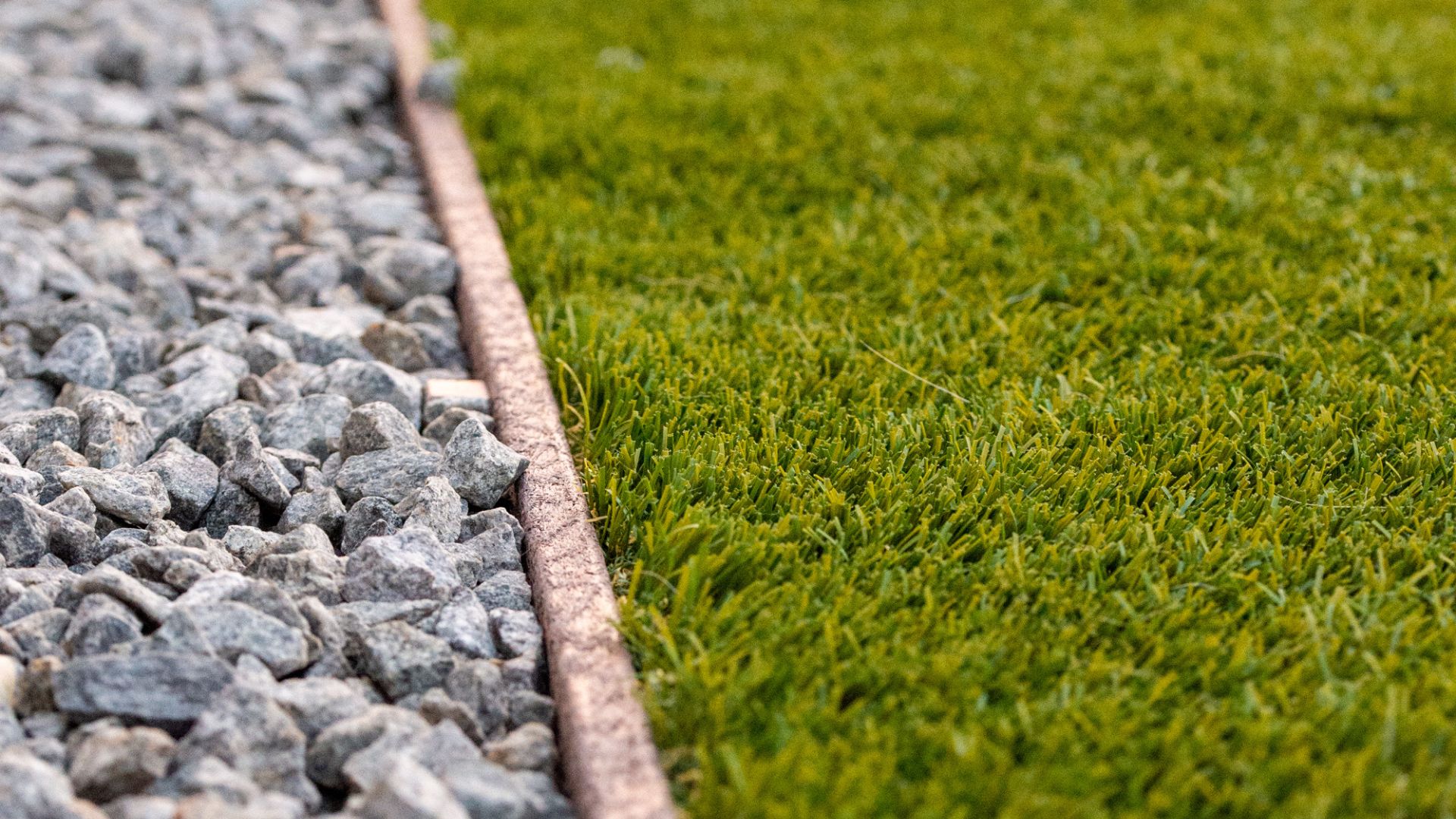The landscape design world is full of beautiful ideas for using natural ground cover in your yard. It’s also full of low-maintenance (and attractive) artificial ground cover ideas. So which is best? Well, have you considered blending the two? You get the best of both worlds, and artificial turf works great in a huge variety of landscaping plans.
Combining real and artificial ground cover types gives you a huge range of options that lend your outdoor space the best of nature’s beauty AND the water-saving, effort-saving, and cost-saving benefits of artificial ground cover options. For example, high-quality artificial grass is a nice, lush canvas to balance a bed of artfully layered clover or moss. Or maybe creating a kid-friendly space with climbable stones of various sizes and some river rocks over the top of fall-friendly rubber mulch is more our speed.
Endless options, so many benefits. And to make sure you understand how to bring the best ground covers into your backyard vision, let’s go over the best ground cover options. We’ll also discuss making your plans, choosing your materials, and bringing it all together beautifully.
Ground Cover Blending: Overview
-
- Combining real and artificial ground covers offers the best of both worlds: natural beauty and low maintenance
- Proper planning and design are crucial for a seamless blend
- This approach can significantly reduce water usage and maintenance costs
- Blended landscapes can increase property value and curb appeal
- With the right combination, you can create a sustainable and visually stunning outdoor space
Why Blend Real and Artificial Ground Cover?
The world is full of skeptics. So maybe some of you are wondering why this blend of ground covers is a good idea. That’s cool. But keep an open mind here, there’s a great reason (or more) for every kind of lawn-owner.
Benefits:
You know how your water bill skyrockets every summer trying to keep your lawn from turning into a crispy critter? Well, scratch that! Blending in artificial elements dramatically reduces your water needs. Using less water = saving more cashola. Oh, you like saving time and money? Well, you’ll love spending your weekends actually enjoying your yard instead of mowing, weeding, and sweating buckets. With a blended landscape, ease back into your hammock and raise an iced bevvy in salute while your neighbors are still pushing their mowers around.
-
- Water conservation: Artificial elements dramatically reduce water needs.
- Lower maintenance: Less mowing, weeding, and overall upkeep.
- Year-round appeal: Always green, always clean.
- Increased usability: Create functional spaces that can handle heavy use.
- Property value: A well-designed blended landscape can boost curb appeal and home value.
I could go on (and I will). A blended landscape creates year-round curb appeal. Always green, always clean. Plus, it’s super versatile. You can create functional spaces made to handle whatever you throw at them – kids, pets, wild parties, you name it. And who doesn’t love boosting their property value? A well-designed blended landscape looks great and performs great, increasing your yard value to potential buyers.
Considerations:
Making smart ground cover and landscaping decisions requires knowing all the variables. And I wouldn’t be doing my job if I didn’t mention a few things to consider. Like pretty much all home projects, there’s an initial investment involved. This goes for natural and artificial ground covers. For fake turf and foliage, upfront cost can be higher than throwing down some sod and calling it a day. But think of it as an investment in your future weekends – you’re basically buying back your free time!
-
- Initial cost: The upfront investment might be higher than a traditional lawn.
- Heat absorption: Some artificial materials can get hot in direct sunlight. The same is often true of some natural elements like stone.
- Environmental impact: artificial grass and foliage require less water-use and pesticide treatments, but don’t generally add to the local ecosystem in meaningful ways. Consider the long-term effects of using synthetic materials.
- Local regulations: Check if there are any restrictions on artificial landscaping in your area.
So, as you’re designing your space, keep in mind your local climate and possible sunny spots. For spaces that won’t see foot-traffic, it might not matter. But it’s something to think about if you love going barefoot, or have kiddos or pets. And while we’re on the topic of planning, don’t forget to check your local regulations. Some areas have restrictions on artificial landscaping – you don’t want to create a masterpiece only to have the HOA come knocking. (Been there. Done that. Two Thumbs down.)
I also always encourage folks to consider the long-term environmental impact of using synthetic materials. We’ve come a long way in developing eco-friendly options, but it’s still something to keep in mind as you’re designing your space. The artificial grass/foliage water-savings are great, as is not having to use chemicals or pesticides to keep your lawn pest-free. On the other hand, a lot of local ecologies rely on natural elements to thrive. Bees, bugs, local water cycles, heat absorption and oxygen generation. These are all great reasons to consider how and where you’re including the natural elements of your ground cover blend.
Ground Cover Types & Tips
Honestly, there are a ton of ground cover options out there. But the most common ones are popular for a reason, so here are the best options, both natural and artificial.
Natural Ground Covers
-
- Grass: The classic choice, but let’s face it, high-maintenance.
- Clover: Low-growing, drought-resistant, and great for pollinators.
- Moss: Perfect for shady areas and adds a magical forest vibe.
- Creeping Thyme: Fragrant, beautiful when in bloom, and can handle light foot traffic.
- Sedum: Succulents that come in various colors and are drought-tolerant.
- Stone: large decorative stones, colorful river rocks, and pea gravel are all durable, water-thrifty options.
Artificial Ground Covers
-
- Synthetic Turf & Foliage: Our bread and butter – looks like grass, feels like grass, but doesn’t need mowing or watering.
- Rubber Mulch: Made from recycled tires, it’s great for playgrounds and doesn’t fade.
- Artificial Moss: For when you want that lush forest floor look without the humidity requirements.
- Faux Rock: Lightweight and can add texture without the heavy lifting.
Assessing Your Landscape Needs and Goals
Before we dive headfirst into the wonderful world of blended landscapes, let’s pump the brakes and talk about what you really want. I mean, sure, we could go hog-wild mixing and matching real and artificial elements like we’re hosting some kind of horticultural fashion show, but that might not give you the yard of your dreams.
Are you sick and tired of your water bill rivaling your mortgage payment every summer? Then water conservation might be at the top of your list. Or maybe you’re looking to trade in your weekends of mowing, weeding, and cursing at stubborn dandelions for some quality hammock time. In that case, low maintenance is your new best friend.
Now, for all you eco-warriors out there (and trust me, I see you, and I salute you), creating a more environmentally friendly space might be your jam. And hey, who doesn’t want to impress the neighbors and make their home the talk of the block? If boosting your curb appeal is on your mind, we’ve got you covered. Oh, and let’s not forget about those of you with little ones (two-legged or four-legged, we don’t discriminate). If you need a durable area that can withstand the chaos of playtime without looking like a war zone, that’s definitely something to consider.
The point is this: figure out your priorities and create a roadmap for your landscape. It’ll guide your choices when it comes to blending real and artificial elements, helping you create a space that’s not just pretty to look at, but also perfectly tailored to your lifestyle.
Planning the Integration of Real and Artificial Ground Covers
You’ve learned the why, options, and considerations for blended ground cover. So, how do you take all this knowledge and take the next step … into your new, beautifully artful ground cover backyard? Well, here are some great (and simple) tips to get you going.
Create zones: Zoning your outdoor space is both beautiful and practical. Designate unique areas for different purposes. Maybe you want a low-maintenance artificial turf putting green, surrounded by a border of live flowering plants. Or a pet play area separated from your comfy sitting spot in the shade.
Consider traffic patterns: Durable artificial turf is fantastic in high-traffic areas, then soften the edges with real ground covers. Creating specific paths with stones and/or pavers also creates a guided walking experience.
Play with textures and senses: Mix the smooth, uniform look of synthetic turf with the varied textures of natural stone or living moss. And while artificial foliage can be isntalled for a lush, green vertical garden look, bringing in real thyme or basil is a treat for your nose.
Think about color: Use the consistent green of artificial turf as a backdrop for pops of color from real flowers or shrubs. Then consider how neutrals like stone or gravel can add yet another layer to your visual pallete.
Mind the transition: Create natural-looking boundaries between real and artificial elements using rocks, mulch, or curved edges.
A Ground Cover For Every Purpose
Different landscaping areas have different purposes and needs, right? And your choice of ground cover for each area will definitely impact how well it performs (and survives). So think about your outdoor space design goals, and then take a look at these ground cover options (natural and artificial). The better a painter understands their paints, the more masterful their painting can be.
-
- Around pools: Artificial turf doesn’t get muddy and dries quickly.
- High-traffic zones: Look for tough, resilient plants like clover. Durable artificial turf also resists wear-and-tear well while looking great.
- Play areas: Synthetic turf or rubber mulch can provide a safe, cushioned surface.
- Roof, balcony or patio gardens: Lightweight artificial foliage can create green spaces where real plants might be impractical.
- Shaded nooks: Moss or shade-loving perennials like hostas can thrive here.
- Shady spaces: Real grass can struggle in the shade, but artificial turf stays beautifully green.
- Slopes: Choose plants with strong root systems to prevent erosion.
- Sunny spots: Go for drought-resistant options like sedum or creeping thyme. Avoid stone or gravel if you live in a hot environment, as it can burn little bare feet or paws.
How To Get That Natural Look
Getting the right balance of elements, colors, textures, and shapes is tricky for any landscaper. But the goal is always to create a natural look, regardless of your style. The good news is that there some simple tricks and tactics you can use.
Use curves: Nature doesn’t do straight lines, so use curved borders where possible. This helps the transition from natural ground cover to artificial feel less rigid and manufactured.
Layer it up: Nature also doesn’t do one-dimensional. So create depth by layering different heights, colors and textures.
Add hardscaping: Incorporate natural stone pathways or retaining walls to bridge the gap between real and artificial.
Don’t forget the details: Modern, quality artificial grass and foliage has a lot of options for adding those “real touches”. But you can take it to the next level by adding realistic touches like fallen leaves or moss growth on your artificial elements.
Maintaining Real and Artificial Ground Covers Together
One of the beauties of a blended landscape is the reduced maintenance. For some of us, it’s THE reason to go synthetic. But you still need to show it some love to keep it looking its best, for the longest:
-
- Real ground covers: Regular weeding, occasional pruning, and specific care based on plant type.
- Artificial ground covers: Periodic rinsing, brushing of synthetic turf, and inspection for any damage.
- Borders: Keep edges neat between real and artificial areas.
- Seasonal tasks: Adjust care routines based on the time of year and local climate.
What Are You Waiting For?
There’s a lot of information and detail in this guide, but don’t get overwhelmed. Successfully blending natural and artificial ground cover is all about creating your vision, making a plan, then finding the right ground cover solution for each area.
And if you’re still a little worried, give the Artificial Turf Supply team a call at (866) 677-9405. They have decades of experience, and they’d love to hear about your outdoor living vision.
And if you’re ready to start looking at pricing, check out our free artificial grass quote tool.






